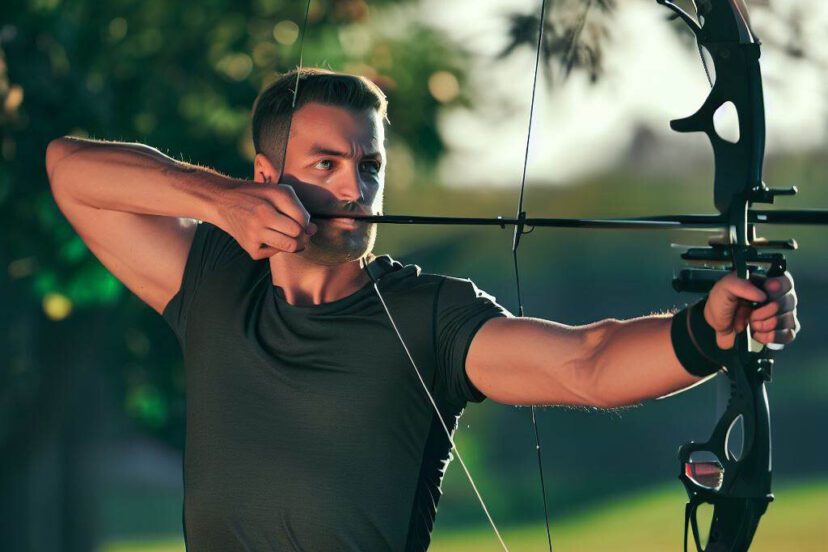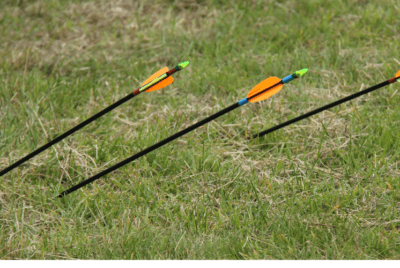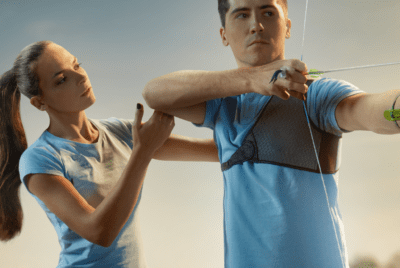Mastering the Perfect Bow and Arrow Position: A Step-by-Step Guide
When it comes to archery, the position of your body, hands, and feet plays a crucial role in determining the accuracy and consistency of your shots. Mastering the proper bow and arrow position is the foundation for achieving precision and success in archery. In this article, we will delve into the key elements of the archer’s stance, grip and hand placement, drawing technique, release, aiming, common mistakes to avoid, practice tips, equipment considerations, and more.
Understanding the Importance of Bow and Arrow Position
Before we dive into the specifics, it is essential to understand why bow and arrow position is of paramount importance in archery. The alignment of your body, hands, and feet directly influences the path and flight of the arrow upon release. A well-executed position ensures efficient transfer of energy from the bow to the arrow, resulting in a smoother and more accurate shot. Consistency in your position allows for reliable shot replication, improved muscle memory, and enhanced proficiency over time.
The Basic Archery Stance
The foundation of a good bow and arrow position lies in the archer’s stance. Let’s break it down into three key components: feet placement, body alignment, and shoulder position.
Feet Placement
To establish a stable base, position your feet shoulder-width apart, with your toes pointing toward the target. Distribute your weight evenly between both feet, ensuring a solid and balanced stance. Avoid excessive leaning or favoring one foot over the other, as it can negatively affect your balance and accuracy. However, depending on the shooting style or archery discipline you practice, there may be variations in feet placement. Explore different styles and consult with experienced archers to find the most suitable foot placement for your needs.
Body Alignment
Maintaining proper body alignment is vital for consistent shooting. Stand up straight, keeping your shoulders back and your chest open. Align your body with the target, ensuring that your hips, shoulders, and feet are in line. This alignment allows for a direct transfer of energy from your body to the bow and arrow. However, specific shooting styles may require slight variations in body alignment. For example, in some traditional archery styles, a slight cant (tilt) of the bow may be employed. It is crucial to understand the requirements and principles of your chosen shooting style and make adjustments accordingly.
Shoulder Position
Your shoulder position greatly influences your ability to maintain stability and execute a smooth shot. Keep your non-dominant shoulder (the shoulder opposite to your drawing hand) relaxed and slightly forward. This positioning helps maintain a straight line from your drawing arm to the target, allowing for better accuracy and reduced torque on the bow.
The Grip and Hand Placement
The grip and hand placement on the bow are crucial for control and consistency. Let’s discuss the optimal technique for both your bow hand and drawing hand.
For your bow hand, place it on the grip with a relaxed and firm grip. Avoid gripping the bow too tightly, as it can result in unnecessary muscle tension and interference with the bow’s natural movement during the shot. Instead, maintain a gentle but secure hold on the grip. Position your hand slightly angled and in line with your forearm to provide stability and reduce the chance of torquing the bow upon release. Keep your fingers relaxed and lightly curled around the bow grip, with the thumb resting comfortably against the side of the grip.
As for your drawing hand, also known as the hand that holds and draws the bowstring, aim for a consistent and relaxed grip. Position your fingers around the bowstring, with the index finger above the arrow nock and the remaining fingers below. This grip allows for a controlled and smooth release of the arrow.
Drawing the Bowstring
Drawing the bowstring is a critical part of the archery process, as it determines the power and trajectory of the shot. Let’s explore the key elements involved in drawing the bowstring: the anchor point, elbow position, and back tension.
Anchor Point
The anchor point is a reference point on your face where you consistently bring the hand that draws the bowstring. Common anchor points include the corner of the mouth, the jawline, or the side of the nose. Select an anchor point that feels comfortable and allows for consistent alignment and aim.
Consistently using the same anchor point helps improve accuracy by ensuring a consistent draw length and release point. It also aids in maintaining proper body alignment throughout the shot process.
Elbow Position
As you draw the bowstring, pay attention to the position of your elbow. Keep your elbow high and in line with the arrow, avoiding a collapsed or low elbow. This position allows for better control, power, and a straighter release. It also helps engage the larger muscles of the back, contributing to a smoother and more controlled shot.
Back Tension
Maintaining back tension throughout the shot is crucial for stability and control. Focus on squeezing your shoulder blades together as you draw the bowstring, engaging the muscles of your upper back. This tension provides a solid foundation for a controlled release and enhances your overall shooting form.
Release Technique
The release is the moment when you let go of the bowstring, allowing the energy stored in the bow to propel the arrow towards the target. A smooth and consistent release is vital for accuracy and minimizing bowstring interference.
As you reach full draw, focus on relaxing your fingers and letting the bowstring roll off the fingertips naturally. Avoid any sudden or jerky movements during the release, as they can disrupt the arrow’s flight path. A controlled and relaxed release allows the arrow to leave the bow smoothly and improves your chances of hitting your target.
Aiming and Sight Alignment
Once you have mastered the bow and arrow position, it’s time to focus on aiming and sight alignment. Aiming involves aligning your sight or the tip of your arrow with the target to ensure accuracy. Different archery styles employ various aiming techniques, such as instinctive aiming, gap shooting, or using sights. Experiment with different methods and choose the one that suits you best.

For those using a sight, ensure that it is properly calibrated and adjusted for your shooting distance. Practice aligning the sight pin with the target, keeping a steady hand and a relaxed focus. Remember to maintain your proper bow and arrow position while aiming to ensure consistent and accurate shots.
Sight alignment is another crucial aspect of archery. It involves aligning your dominant eye, the bowstring, and the target. Your dominant eye should be directly behind the bowstring, with a clear line of sight to the target. This alignment helps you maintain focus and improves your accuracy.
Practice and experimentation are key when it comes to aiming and sight alignment. Find the method that works best for you and dedicate time to refine your skills through consistent practice sessions.
Common Mistakes to Avoid
In the pursuit of mastering the bow and arrow position, it’s essential to be aware of common mistakes and pitfalls that can hinder your progress. Let’s discuss a few mistakes to avoid:
Gripping the Bow Too Tight: A tight grip on the bow can lead to muscle tension, negatively affecting your aim and shot execution. Maintain a relaxed and firm grip without excessive force.
Flinching or Anticipating the Shot: It’s common for archers to anticipate the shot and flinch, which can disrupt the accuracy and consistency of your shots. Focus on maintaining a calm and composed mindset, practice relaxation techniques, and emphasize a smooth and controlled release to overcome these tendencies.
Poor Follow-Through: Neglecting the follow-through can impact the shot’s execution and accuracy. After releasing the arrow, maintain your form and focus on the target. Allow your bow hand to follow the natural path of the shot, extending towards the target. This smooth and complete follow-through helps maintain balance and control until the arrow reaches its destination.
By being mindful of these common mistakes and actively working to avoid them, you can significantly improve your shooting technique and overall performance.
Practice and Consistency
Mastering the bow and arrow position requires practice and consistency. Regular training sessions dedicated to refining your technique will yield significant improvements in your archery skills. Focus on each element of the position, from stance to grip, and dedicate time to repetition and muscle memory development.
Consistency is key in archery. Aim to replicate the same position and shot process each time you draw the bow. By establishing a routine and maintaining consistency, you enhance your ability to hit the target consistently and improve your overall performance.
Choosing the Right Bow and Arrow Position for You
While the fundamentals of bow and arrow position remain constant, it’s important to note that each archer is unique. Factors such as body type, strength, and personal preferences can influence the optimal position for an individual. Experiment with different techniques and make adjustments based on what feels most comfortable and natural to you.
Consider seeking guidance from a qualified archery instructor or coach who can assess your form and provide personalized recommendations. They can help you fine-tune your position to maximize your shooting potential and address any specific challenges or areas of improvement.
Equipment Considerations
In addition to proper form, the equipment you use in archery can significantly impact your performance. Ensure that your bow is properly sized and suited to your body type and strength. Seek advice from experienced archers or archery professionals to select the appropriate draw weight and bow length for your needs.
Additionally, consider the accessories that can aid in improving your shooting, such as stabilizers, sights, and arrow rests. Experiment with different equipment configurations to find what works best for you and complements your bow and arrow position.
Fine-Tuning Your Technique
As you progress in your archery journey, continue to refine your technique and make adjustments as needed. Regularly assess your form, seek feedback from experienced archers or coaches, and be open to incorporating new strategies and improvements into your shooting routine.
Remember that archery is a continuous learning process, and even experienced archers continually strive to refine their technique. Embrace the opportunity for growth and improvement, and never shy away from seeking guidance or trying new approaches to enhance your skills.
Safety Measures and Etiquette
Safety should always be a top priority in archery. Familiarize yourself with the range rules and adhere to them at all times. Maintain awareness of your surroundings and never point your bow or arrow in an unsafe direction. Additionally, always use proper protective gear, such as an armguard and finger tab or release aid, to prevent injuries.
Archery is also a sport rooted in etiquette and respect. Follow the rules of the range or shooting venue, demonstrate good sportsmanship, and be considerate of others sharing the space. Respect the equipment of others and the range facilities, ensuring cleanliness and tidiness.
Mental Focus and Visualization
Archery is not solely about physical technique; mental focus and visualization also play integral roles. Cultivate a calm and focused mindset before each shot. Develop relaxation techniques that help you remain composed and eliminate distractions. Visualization exercises can aid in improving your aim and shot execution. Visualize the arrow hitting the target with pinpoint accuracy, creating a mental image of success.
Maintaining mental discipline and focus throughout your archery sessions can greatly enhance your shooting performance. Practice mindfulness techniques and find strategies that help you stay present and engaged during your practice or competition.
Conclusion
Archery is a beautiful and rewarding discipline that requires dedication and practice. By mastering the fundamentals of bow and arrow position and continuously refining your technique, you can elevate your archery skills to new heights. Embrace the process, remain open to learning, and enjoy the journey as you strive for accuracy, consistency, and personal growth in archery.
As you progress, remember to always prioritize safety, respect range rules and etiquette, and engage in regular warm-up exercises to prevent injuries. Additionally, don’t underestimate the power of mental focus, visualization, and maintaining a calm mindset to enhance your shooting performance.
Whether you’re practicing target archery, bowhunting, or any other archery discipline, the principles of proper bow and arrow position remain foundational. However, it’s important to tailor your position to suit your unique body type, strengths, and preferences.
Lastly, remember that archery is not only a physical endeavour but also an opportunity for personal growth, discipline, and self-improvement. Embrace the challenges, seek guidance when needed, and enjoy the satisfaction of consistently hitting your targets with precision and skill.
So, grab your bow, take aim, and let the arrow fly true as you master the art of bow and arrow position in archery.
FAQs
Q: Can I practice bow and arrow position without a bow?
A: Yes, you can practice elements of the bow and arrow position even without a bow. Focus on exercises that improve your stance, body alignment, and hand placement. You can simulate the drawing motion and work on your anchor point and release technique using a resistance band or a stretch band.
Q: Are there specific exercises to strengthen the muscles used in the bow and arrow position?
A: Yes, there are exercises that can help strengthen the muscles involved in the bow and arrow position. Resistance training exercises targeting the back, shoulders, core, and arm muscles can enhance stability, control, and overall shooting performance. Consult a fitness professional or archery coach for personalized exercise recommendations.
Q: Is it necessary to warm up before shooting with the bow and arrow position?
A: Yes, warming up is essential to prepare your body for the physical demands of archery. Engage in light cardiovascular exercises, such as jogging or jumping jacks, to increase blood flow. Perform dynamic stretches to loosen up your muscles and improve flexibility. This warm-up routine helps prevent injuries and optimizes your shooting performance.
Q: Can I adjust my bow and arrow position for different types of archery, such as target archery or bowhunting?
A: Yes, different types of archery may require slight adjustments to the bow and arrow position based on the specific requirements of the discipline. Seek guidance from experienced archers or coaches specializing in the type of archery you are interested in to learn the optimal position for that particular discipline.
Q: What should I do if I experience discomfort or pain while practicing the bow and arrow position?
A: Discomfort or pain may indicate incorrect form or excessive strain on certain muscles. Take a break and assess your technique. Make sure you are not overexerting yourself and seek guidance from a qualified instructor to identify and correct any potential issues with your form or equipment. It’s important to prioritize your safety and well-being while practicing archery, so don’t hesitate to address any discomfort or pain promptly.







Comments are closed.